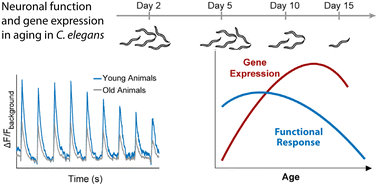Microfluidic approach to correlate C. elegans neuronal functional aging and underlying changes of gene expression in mechanosensation†
Abstract
The aging process has broad physiological impacts, including a significant decline in sensory function, which threatens both physical health and quality of life. One ideal model to study aging, neuronal function, and gene expression is the nematode Caenorhabditis elegans, which has a short lifespan and relatively simple, thoroughly mapped nervous system and genome. Previous works have identified that mechanosensory neuronal structure changes with age, but importantly, the actual age-related changes in the function and health of neurons, as well as the underlying genetic mechanisms responsible for these declines, are not fully understood. While advanced techniques such as single-cell RNA-sequencing have been developed to quantify gene expression, it is difficult to relate this information to functional changes in aging due to a lack of tools available. To address these limitations, we present a platform capable of measuring both physiological function and its associated gene expression throughout the aging process in individuals. Using our pipeline, we investigate the age-related changes in function of the mechanosensing ALM neuron in C. elegans, as well as some relevant gene expression patterns (mec-4 and mec-10). Using a series of devices for animals of different ages, we examined subtle changes in neuronal function and found that while the magnitude of neuronal response to a large stimulus declines with age, sensory capability does not significantly decline with age; further, gene expression is well maintained throughout aging. Additionally, we examine PVD, a harsh-touch mechanosensory neuron, and find that it exhibits a similar age-related decline in magnitude of neuronal response. Together, our data demonstrate that our strategy is useful for identifying genetic factors involved in the decline in neuronal health. We envision that this framework could be applied to other systems as a useful tool for discovering new biology.



 Please wait while we load your content...
Please wait while we load your content...